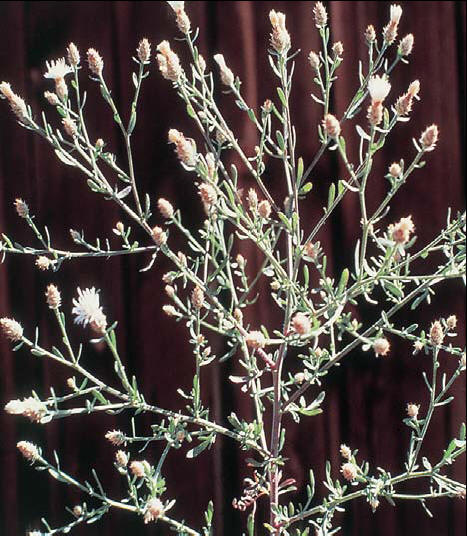|
Description:
Diffuse knapweed is a biennial, short-lived
perennial or sometimes annual plant. It grows
about 2 feet tall from a single branched stem.
Rosette leaves are about 6 inches long and
thinly divided, whereas upper stem leaves are
smaller and smooth-edged. The stem is rough to
the touch. Each branch produces a single
flowerhead at the tips. The flowers vary from
white to pinkish. Bracts on the flowerheads bear
small, yellowish spines with small teeth-like
projections along the sides. The seeds are brown
to grey and tipped with a light-colored plume
that drops off as the seed ripens.
Management Guidelines: |
 |
|
Type and Class of
Livestock:
All classes of sheep, goats, and cattle.
Grazing Objective:
Graze heavily at least twice each year to
prevent flowering and for three or more years to
reduce populations.
Growth Stage for
Treatment:
For sheep, it is best to graze diffuse knapweed
in the rosette or bolted stages. Goats will
graze all growth stages. Palatability for cattle
quickly declines beyond the bolting stage. A
minimum of two grazing treatments per year is
necessary to prevent seed formation, and a
minimum of three years is required to reduce
populations.
Potential Effectiveness:
Diffuse knapweed is readily grazed by sheep,
goats, and cattle up through the early
vegetative stages. Palatability is reduced as
the plant ages especially for sheep and cattle.
Diffuse knapweed is not as palatable as spotted
knapweed. Targetedgrazing grazing can reduce
plant vigor, size, and flower production.
Long-term control depends on the prevention of
flower and seed production. Grazing must be
applied at least twice per year over several
years to be effective. Remove livestock for
approximately two weeks and regraze to prevent
seed head formation. Grazing is most effective
when combined with herbicide treatments. |
|
References:
Beck, K.G. 2000.
Diffuse and spotted knapweed. Colorado State
University Cooperative Extension. Fact Sheet No.
3.110. 2 p.
Beck, K., J.R.
Sebastian, and L.R. Rittenhouse. 1998. The
influence of cattle grazing on diffuse knapweed
populations. In: Colorado. Proceedings,
Western Society of Weed Science. 15:63
(Abstract)
Roche, B.F. and C.T.
Roche. 1999. Diffuse knapweed. In: R.L.
Sheley and J.K. Petroff [EDS.]. Biology and
management of noxious rangeland weeds.
Corvallis, OR: Oregon State University Press. p
217-230.
Sheley, R.L., J.S. Jacobs, and M.F. Carpinelli.
1998. Symposium – Distribution, biology, and
management of diffuse knapweed (Centaurea
diffusa) and spotted knapweed (Centaurea
maculosa). Weed Technology
12:353-362.
|